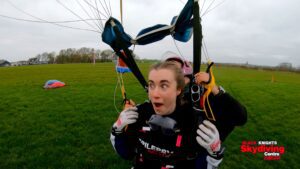Lisa and David were devastated when their new baby developed epilepsy – and conventional treatment simply wasn’t stopping his seizures. Would Cole ever find a new treatment option that would allow him to become seizure-free?
Cole was born on 26 July 2012 weighing 8lb 10oz. He was one day early and labour lasted only 35 minutes – just enough time to make it to Wishaw General Hospital. He was born very healthy and we were both home within a few days. Like most babies, he cried, fed and slept. Cole completed our family. We now had our two gorgeous boys.
When Cole was just over two months old, I was feeding him when I noticed something. As he lay in my arms, he jerked. It looked like he’d had a fright. Both of his hands came up to his chin and his eyes rolled back. It only lasted for a few seconds, then he went back to drinking his milk.
My gut said, ‘That’s not right,’ and gave me a sick feeling. But was I just being a bit of an over-protective mum? New mums worry, don’t they? When Cole’s dad David got home, I told him about it. Knowing me well (I often panic a bit), David replied: “He’s a wee bruiser. There’s nothing wrong with him.”
That night, we went to David’s parents for dinner – and Cole did it again. But no one saw it, except me.
Seeking help
By the next day, I was watching Cole’s every move – terrified. Only now the jerks were happening every hour, in clusters of 10. I grabbed David’s phone and recorded this jerking. Afterwards, I phoned the doctor.
We were told to take Cole to our GP, Dr Fraser Wylie. Dr Wylie saw us straight away, but – as usual when you take your child to the doctor – the jerking had stopped. The doctor checked his blood pressure, temperature and responses. All fine. Nothing seemed to be wrong. We then showed the doctor the video. He asked to be excused as he wanted to seek advice from a paediatrician at Wishaw hospital. He wasn’t sure about the jerking.
A few moments later Dr Wylie returned. He said a paediatrician at Wishaw – Dr Callaghan – would be waiting to see us on arrival. By the time we left the surgery, Cole was jerking again.
The next part of Cole’s story was the most devastating few hours of my life. We were told by Dr Callaghan that she thought Cole might have West Syndrome. David and I had no idea what West Syndrome was. We knew it wasn’t good because we were told to immediately take Cole to Yorkhill Hospital.
On the way to Yorkhill, I was crying. David remembered some boys in his school who had epilepsy. He was saying how they were picked on and called names. All the way to the hospital, I prayed. I’m not even religious, but I prayed – promising to be good forever, just as long as my baby was okay. I just thought, ‘Please let it be a virus.’
On arrival at Yorkhill, we met Margaret Wilson and Dr Stewart McLeod. Cole was examined and then they both watched our video of Cole over and over again. We were then asked to sit down.
Dr McLeod explained that Cole was having infantile spasms. They couldn’t be certain until further tests were carried out – but what they were seeing was similar to West Syndrome.
David asked: “What are Cole’s best- and worst-case scenarios if he does have West Syndrome?”
We were told that, at best, Cole would have learning difficulties and possibly a disability. Worst-case scenario? He wouldn’t live past the age of five. We had to wait to receive an appointment so that Cole could have further tests. So – in bits, confused, terrified and devastated – we left the hospital. We had our gorgeous tiny baby boy and a leaflet on West Syndrome.
That night we both cried. Suddenly everything was different. Two days earlier we had – as far as we knew – a perfectly healthy baby boy. Why now? What did this all mean?
A testing time
Cole’s diagnosis came very quickly, really. Within the first few months of his seizures starting, we knew what was wrong. Within weeks of seeking medical help, Cole had undergone several tests. So there we were: sat down waiting for the results.
The doctors told us that Cole did not have West Syndrome. That was a huge relief to us all – but we were still heartbroken to be told that he did have epilepsy. Specifically, he has focal epilepsy in his left temporal lobe.
His diagnosis was followed by months and then years of tests, travelling to and from hospitals and trying different epilepsy treatments. During this period, Cole’s consultants tried every medication they could. None controlled his seizures. The longest period of seizure freedom Cole had was in November 2013 and lasted just 21 days.
The furthest we travelled from our home in Scotland was to London, where Cole had a very detailed brain scan. Cole also stayed in Yorkhill and the Royal Hospital for Sick Children for other tests. This included one where Cole had over 20 tiny wired pads glued all over his tiny head. He then had to stay in this tiny cot for 24 hours as a camera recorded his every move. That’s a big ask for a wriggling toddler!
As a family, we watched him have seizure after seizure. His body was left exhausted and sore. Cole was unable to get proper sleep, he was up every few hours screaming and crying. We saw his development slow down or freeze altogether. We watched his mood, behaviour and social skills increasingly worsen over his first two years of life.
During all this time, our oldest son Dylan (who is now five) was amazing – a constant joy to not only me and his dad, but to Cole, too. Dylan has always been a fantastic big brother. He always looked after Cole and would alert me if he had a seizure.
Dylan had to grow up a lot quicker than most five-year-olds, but he just got on with it. He never moaned when he was passed around different family members while we spent days in hospital. He never moaned about the sleepless nights with Cole’s screaming. Dylan is such a good boy.
Wonderful news
After two years of tests, heartache and constant uncertainty, we received some incredible news. We were told that Cole had one option – and only one option – to live a seizure-free life: he could have a lesionectomy on his left temporal lobe. Cole was a candidate for epilepsy brain surgery. This operation would be carried out at the Royal Hospital for Sick Children. Once the decision to have surgery was made, we were given the date of the operation really quickly.
Before his surgery, we had a number of meetings with the surgeons – Mr Sokol and Mr Kandasami. The surgeons spoke to us about all of the possible risks and made sure that we were fully aware of everything that would and could happen. One of the risks that really concerned us was that Cole might lose his speech.
On 26 November 2014 Cole had brain surgery. He went away with the surgeons at 8.30am and we got the call at 4pm to say Cole was out of surgery. We were so worried, but as we walked to go get our boy, I could hear him shouting for us: “Mum! Dad!” The tears poured down my face with relief. He was out of surgery. He was awake. He could speak.
We spent seven days and nights in Ward 7a. The amazing staff looked after Cole and David and I. Cole’s recovery was amazing during the first two days, but then then he took ill and started being sick. Thankfully this only lasted two days and then Cole was back on his feet – showing us just how tough he really is.
Even with his face so badly swollen that he couldn’t open his eyes, he was still full of cheek and carry on. By day four he was up on his feet. On day five he held our hands as he walked up and down the ward. Our son Cole, the superstar.
Cole has only had one seizure since his surgery. Although we still have some way to go, the reduction in his seizures allows us to focus on everything else. We will continue to keep working to give our boy the best chance in life. But this would not have been possible without the amazing family and friends we have around us and, of course, the fantastic medical team around Cole.
If you feel that your seizures are affecting your health and wellbeing, there are some ways of changing that without even leaving your home!
Epilepsy Action Learning is an e-learning platform that includes a variety of different courses. One of those courses is called Epilepsy and your wellbeing.
Sign up now for access to this free online course. It helps you assess your own wellbeing and offers you information about how to take steps to improve it.




